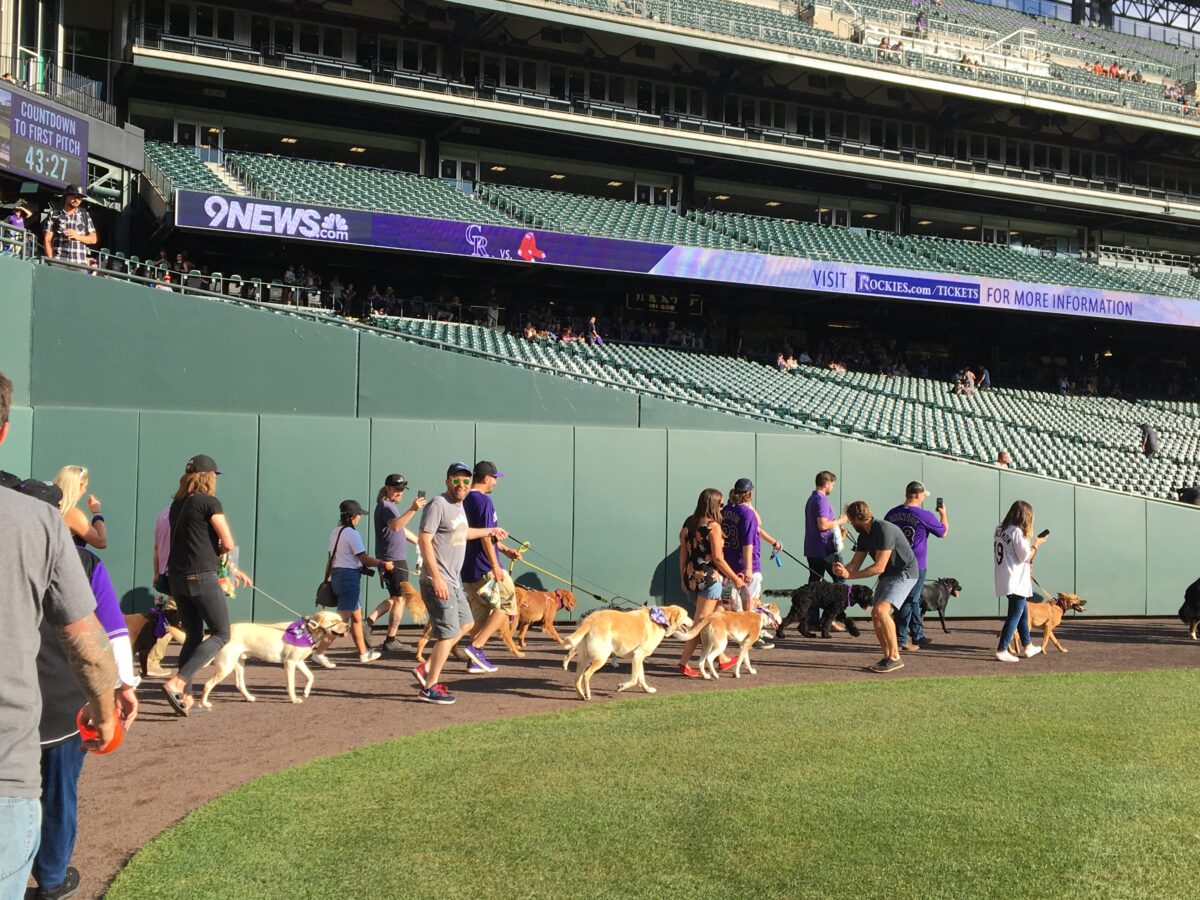As a baseball fan and dog nut, I was delighted a few years ago when the Colorado Rockies announced tickets were on sale for a dog-friendly event called Bark at the Park. Rockies fans could bring their socialized, vaccinated dogs to Coors Field to watch an actual MLB game.
I bought tickets, submitted my dogs’ shot records, and the day finally came. My husband Bryan and I took our 90-pound Lab mix, Rio, and our 9-pound poodle mix, Peach, to a Rockies game – along with 800 other dogs and their people. We all sat in a special section in the outfield with potty areas, but before the game, we had the chance to parade around the field with our pups.
Rio always likes to lead, so he and Bryan burst onto the field with excitement. I started taking photos of them when I felt the leash attached to Peach go taut. I turned around to see Peach pancaking onto the ground – frozen in terror as a sea of dogs surged around her. I swept her into my arms and carried her around the field as she trembled.
With a stab of guilt, I realized she would have been much happier at home. Bark at the Park was a good fit for outgoing Rio, but it was way too stressful for little Peach.
If we truly care about reducing fear, anxiety, and stress for our dogs, we need to consider their individual needs before taking them to big events like baseball games, according to Nicole Ellis, CPDT-KA, a Fear Free certified dog trainer, pet lifestyle expert, and author of “Working Like A Dog.”
“We need to understand when it’s the right time to bring our dogs with us and when they might actually be happier at home playing with their favorite toys or relaxing on the couch,” she says.
A key to that is learning our dogs’ body language. Ellis recommends the book “Doggie Language: A Dog Lover’s Guide to Understanding Your Best Friend” by Lili Chin because the illustrations are easy to understand for kids and adults alike.
Many people overlook canine stress signs like lip licking, “whale eye,” yawning, or averting their gaze – which can then escalate to lunging or snapping.
“Often I see dogs in situations where people didn’t notice they were showing signs of stress until it gets pretty extreme,” she says. “So if we can understand their body language a bit more, we can set them up better for success.”
Another way to set dogs up for successful public outings is to take “baby steps” instead of throwing them into a large event like a sporting event or outdoor concert. Ellis enjoys taking her own dogs, Maggie and Rossi Bear, on public excursions. But she started with smaller crowds and events that weren’t too loud and suggests others do the same.
“There are lots of ways we can get our dogs used to these environments, like outdoor shopping malls if they’re pet-friendly,” she advises. “Start in the morning, when there are less people out, and then work up to going on a weekend.”
Another tip: play YouTube videos of fireworks or traffic at home. Start at a low volume and look for stress signs. If the dog seems comfortable, reward that calm behavior with praise, a toy, or a treat.
Ellis also recommends using positive training methods at home to teach a dog the cue “Place” (or alternately, “Go to your bed”) so they can go onto a dog bed or mat and feel safe. Then bring that mat on outings to restaurants or cafes so they know to settle into their place when it’s time.
You can also practice skills like “sit” or “touch,” then try them outside where there’s more noise or distractions. If they can’t perform the behaviors, assess if they are too distracted or if they are feeling overwhelmed by the environment and should head back home.
It’s particularly important to remember that many dogs have become accustomed to spending more time at home during the pandemic, so we need to pay attention to their body language to make sure they are comfortable on outings – and leave if they aren’t.
Ellis also notes that something a dog enjoys as a puppy might change as an adult or senior. Older small dogs might feel more comfortable in a pet bag or stroller, for instance. “The whole point of Fear Free is taking the fear out of our pet’s experience – whether that’s training, vet visits, or going to fun events together,” she says. “So we need to really pay close attention to our pets’ stress signs that they’re communicating clearly to us and act on those, but also spend some time training and bonding together to set them up to be able to enjoy these situations.”
This article was reviewed/edited by board-certified veterinary behaviorist Dr. Kenneth Martin and/or veterinary technician specialist in behavior Debbie Martin, LVT.
Award-winning journalist Jen Reeder is former president of the Dog Writers Association of America.
Want to stay in the loop on the latest and greatest in keeping your pet happy and healthy? Sign up for our free newsletter by clicking here!








